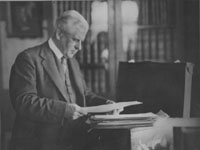


History of Research in the Bureau of Meteorology
Foreword
Preface
Introduction
Chapter 1: Germination and Growth
The First Three Decades
A Time of Rapid Growth
Chapter 2: Struggle, Competition and Emergence
Appendix 1: Meteorology Act 1906
Appendix 2: Meteorology Act 1955
Appendix 3: Simpson Report
Appendix 4: Survey Questionnaire
Appendix 5: Bibliography
References
Index
Search
Help
Contact us

This situation meant that meteorological research could only be authorised by a very liberal interpretation of subsection (g) of Section 4 of the 1906 Meteorology Act "such other duties as are prescribed to give effect to the provision of this Act". Clearly, this was not a strong basis on which to defend the Bureau against the CSIRO, especially when the latter finally decided to undertake its own meteorological research in 1946.
H. A. Hunt BA, a former member of the Sydney Observatory staff, was appointed Commonwealth Meteorologist in early 1907 and soon after convened a scientific advisory committee to assist him in the implementation of the provisions of the new Act.

This group, which comprised Hunt as President, G. H. Knibbs, T. W. E. David, T. R. Lyle, W. H. Bragg, W. E. Cooke, R. F. Griffiths, H. C. Kingsmill and P. Baracchi, met from 20 to 23 May 1907 and made a number of recommendations regarding the work of the new Bureau. For the record, after Hunt, these were respectively, Commonwealth Statistician; Professor of Geology, the University of Sydney; Professor of Natural Philosophy, the University of Melbourne; Elder Professor of Mathematics, the University of Adelaide; Western Australian Government Astronomer; South Australian Government Meteorologist; Tasmanian Government Meteorologist; Victorian Government Astronomer.
The matters decided included the adoption of a standard set of instruments to be supplied to the various types of stations, the designation of the Kew barometer as the instrument of choice for country offices, the design of an Australian standard screen in which to expose the various thermometers and the time of observation for each of the states and territories, so as to provide the best set of observations on which to base the forecasts (Hunt [40]).
Recommendations were also made by a subcommittee of the conference (Hunt, Lyle, Bragg, Baracchi and Knibbs), for a program of research to be undertaken for the improvement of forecasts and a better understanding of the Australian climate. It was recognised even then that the Bureau's efficiency would be enhanced and morale boosted if some Bureau staff were given the opportunity to undertake research work. In addition, it was realised that supporting research would require staff to be provided with the appropriate amount of time in which to carry out this aspect of their work, free from the daily routine. The conference also suggested that any future appointments to professional positions within the Bureau should have relevant qualifications in mathematics, physics and chemistry (Department of Home Affairs [26]).
People in Bright Sparcs - Baracchi, Pietro; Bragg, William Henry; Cooke, William Ernest; David, Tannatt William Edgeworth; Hunt, Henry Ambrose ; Kingsmill, Henry Charles; Knibbs, George Handley; Lyle, Thomas Ranken
 |
Bureau of Meteorology |  |
© Online Edition Australian Science and Technology Heritage Centre and Bureau of Meteorology 2001
Published by Australian Science and Technology Heritage Centre, using the Web Academic Resource Publisher
http://www.austehc.unimelb.edu.au/fam/0746.html